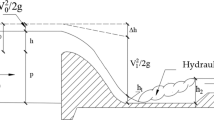Abstract
In the present study, the effects of variation of the upstream width of a chute with semi-circular blocks were investigated on the downstream scour hole dimensions and the rate of dissipation energy based on the experimental and 3D numerical models. Accordingly, four baffled chute models with diverging sidewalls and different width ratios of b2/b1, where b1and b2 upstream and downstream width, respectively, (1, 1.45, 1.75, and 2.45) were designed and tested. Dimension of scour hole included maximum (dsmax) and mean (dsmean) scour depth was measured and calculated. Furthermore, for a constant Froude number (Fr), the maximum and mean scour depths were achieved in the model with a ratio of b2/b1 = 1.45 and b2/b1 = 2.45, respectively. A comparison made between the contraction ratios models showed that the energy dissipation efficiency was improved in the models by 2.62, 5.77, and 3.80%, respectively, relative to the case of the fixed-width model. Our results indicated that the highest energy dissipation efficiency was obtained as 5.77% at a width ratio of (b2/b1 = 1.75). Finally, relationships were presented to estimate the dimensions of the scour hole.


















Similar content being viewed by others
Abbreviations
- L smax :
-
Location of maximum scour hole
- L smean :
-
Location of mean scour hole
- D smax :
-
Maximum scour depth
- D smean :
-
Mean scour depth
- V s :
-
Scour hole volume
- h b :
-
Block height
- b1:
-
Spillway width upstream of the inlet
- b2:
-
Spillway width downstream of the chute
- W :
-
Spillway width downstream of the chute
- Y c :
-
Critical depth of flow over the spillway
- H :
-
Head upstream of spillway in the reservoir
- X :
-
Total length of sedimentary bed
- Y :
-
Total width of sedimentary bed
- M :
-
Length of convergence at upstream
- L :
-
Length of Chute
- Q :
-
Flow discharge
- Fr:
-
Froude number for the flow upstream of the spillway
- ΔE/E :
-
Energy dissipation
- CW:
-
Constant width
- DW:
-
Diverging width
- PED:
-
Energy dissipation performance %
- EDW:
-
Energy dissipation for each width
References
Borja JG, Silva LF, Sanggiotto DG, Marques MG (2013b) Energia residual a jusante de vertedouro tipo salto esqui. Rev Bras Recur Hídr 18(3):205–214. https://doi.org/10.21168/rbrh.v18n3.p205-214
Bormann NE, Julien PY (1991a) Scour downstream of grade-control structures. J Hydraul Eng 117(5):579–594
Bormann NE, Julien PY (1991b) Scour downstream of grade-control structures. J Hydraul Eng 117(5):579–594
Cihat TM, Emin EM (2013) Effect of step geometry on local scour downstream of stepped chutes. Arab J Sci Eng 38:579–588
D’Agostino V, Ferro V (2004) Scour on alluvial bed downstream of grade-control structures. J Hydraul Eng 130(1):24–37
Dargahi B (2003) Scour development downstream of a spillway. J Hydraul Res 41(4):417–426
Farhoudi J, Smith KV (1985) Local scour profiles downstream of hydraulic jump. J Hydraul Res 23(4):343–358
Farhoudi J, Smith KV (2010) Local scour profiles downstream of hydraulic jump. J Hydraul Res 23(4):343–358
Ghazizadeh F, Moghaddam MA (2016) An experimental and numerical comparison of flow hydraulic parameters in circular crested weir using flow3D. Civ Eng J 2:23–37
Huang J, Weber LJ, Lai YG (2002) Three-dimensional numerical study of flows in open-channel junctions. J Hydraul Eng 128(3):268–280. https://doi.org/10.1061/(ASCE)0733-9429(2002)128:3(268)
Hughes WC, Flack EJ (1984) Hydraulic jump properties over a rough bed. J Hydraul Eng 110(12):1755–1771. https://doi.org/10.1061/(ASCE)0733-9429(1984)110:12(1755)
Kaya N, Emiroglu ME (2010) Study of oxygen transfer efficiency at baffled chutes. Proc Inst Civ Eng Water Manag 163(9):447–456
Kotoulas D (1967) Das kolkproblem unter berüchsichtigung der faktoren zeit und geschiebemischung im rahmen derwildbachverbauung. T.U. Braunschweig
Lemos FO, Ramos CM (1987) Hydraulic modeling of free jet energy dissipation. In: Symposium on scale effects in modelling hydraulic structure, Esslingen. Proceedings..., Technische Akademie Esslingen, Esslingen
Novak P (1961) Influence of bed load passage on scour and turbulence Downstream of stilling basin. Presented at the meeting of 9th Congress, IAHR, Dubrovnik, Croatia
Oliveto G, Hager W (2002) Temporal evolution of clear-water pier and abutment scour. J Hydraul Eng 128(9):811–8207
Pagliara S, Palermo M (2009) Influence of tailwater depth and pile position on scour downstream of block ramps. J Irrig Drain Eng 136(2):120–130
Pagliara S, Palermo M (2010) Effect of stilling basin geometry on clear water scour morphology downstream of a block ramp. J Irrig Drain Eng 137(9):593–601
Pfister M, Chanson H (2014) Two-phase air-water flows: scale effects in physical modeling. J Hydrodyn 26(2):291–298
Pfister M, Hager WH (2009) Deflector-generated jets. J Hydraul Res 47(4):466–475. https://doi.org/10.1080/00221686.2009.9522022
Pfister M, Hager WH (2011) Self-entrainment of air on stepped spillways. Int J Multiph Flow 37:99–107. https://doi.org/10.1016/j.ijmultiphaseflow.2010.10.007
Pinto LCS (1994) Estudo teórico-experimental das pressões dinâmicas desenvolvidas no fundo de pré-escavações a jusante de estrutura tipo salto esqui. 376 f. Tese (Doutorado em Engenharia Hidráulica e Sanitária) - Escola Politécnica, Universidade de São Paulo, São Paulo
Raudkivi AJ, Ettema R (1983) Clear-water scour at cylindrical piers. J Hydraul Eng ASCE 109(3):339–350
Schoklitsch A (1932) Kolkbildung unter uberfallstrahlen. Diewasserwirtschaft, pp 341
Shafai RM, Bejestan M (2020) Gene-expression programming approach for development of a mathematical model of energy dissipation on block ramps. J Irrig Eng ASCE 146(2):8318–3249
Shokrian HM, Shafai BM (2018) Predicting the sequent depth ratio of a B-F hydraulic jump on a river-bed rock chute. Proc Inst Civ Eng Water Manag 171(3):143–151
Toombes L, Chanson H (2007) Free-surface aeration and momentum exchange at a bottom outlet. J Hydraul Res 45(1):100–110. https://doi.org/10.1080/00221686.2007.9521748
Zare HK, Doering JC (2012) Energy dissipation and flow characteristics of baffles and sills on stepped spillways. J Hydraul Res 50(2):192–199
Author information
Authors and Affiliations
Corresponding author
Rights and permissions
About this article
Cite this article
Karimi Chahartaghi, M., Nazari, S. & Solimani Babarsad, M. Experimental and Numerical Investigation of the Effect of Diverging Sidewall of Baffled Apron with Semi-circle Blocks on the Energy Dissipation and Scour Hole Dimension at the Downstream. Iran J Sci Technol Trans Civ Eng 46, 1405–1419 (2022). https://doi.org/10.1007/s40996-021-00642-7
Received:
Accepted:
Published:
Issue Date:
DOI: https://doi.org/10.1007/s40996-021-00642-7




